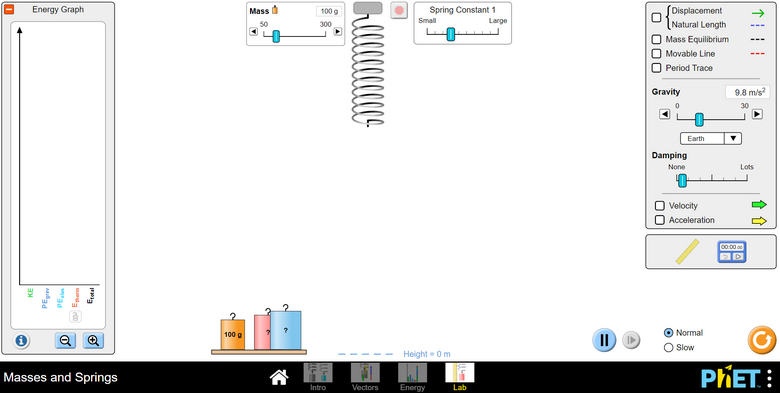Springs: Hooke's Law Review

Overview
This is a review of Springs: Hooke's Law Lab
https://louis.oercommons.org/courses/masses-and-springs
completed by Himanshu Verma, Assistant Professor of Physics at Nicholls State University
Comprehensiveness
The text covers all areas and ideas of the subject appropriately and provides an effective index and/or glossary.
This is an open physics laboratory resource that covers physics experiments related to the concepts of Hooke’s law, spring and its properties. Force on a spring, the reaction force by the spring, and simple harmonic motion of a spring can be explored. The lab helps students explore these concepts through various activities. The resource provides a virtual lab option to high school and college students taking introductory physics course. It provides an option to explore the above mentioned concept using springs of various stiffness and hanging masses. The simulation lets students visualize concept of motion of a spring and relate them to the work-energy theorem.
Content Accuracy
Content is accurate, error-free and unbiased.
Content is accurate, error-free and unbiased.
Relevance Longevity
Content is up-to-date, but not in a way that will quickly make the text obsolete within a short period of time. The text is written and/or arranged in such a way that necessary updates will be relatively easy and straightforward to implement.
In order to run the simulation a user needs to have Adobe flash player updated on their machine. The simulation also needs to be updated with the updates posted for java. However the users have an option to run the simulation on html platform too.
Clarity
The text is written in lucid, accessible prose, and provides adequate context for any jargon/technical terminology used.
A user has to explore by playing around. The ‘intro’ section helps a little. Some YouTube videos are helpful but there are various activities you only can explore by playing around.
Consistency
The text is internally consistent in terms of terminology and framework.
The simulation is designed nicely in terms of consistency. There is ‘intro’ section followed by ‘Vectors’, lab activities and relate the work done on the spring to the spring potential energy. The simulation can be run for spring constants fragile to stiff and hanging mass 50 g to 300 g.
Modularity
The text is easily and readily divisible into smaller reading sections that can be assigned at different points within the course (i.e., enormous blocks of text without subheadings should be avoided). The text should not be overly self-referential, and should be easily reorganized and realigned with various subunits of a course without presenting much disruption to the reader.
The simulation is nicely broken in parts. It starts with the introduction section, followed by Vectors, lab activities, and work-energy relation. The students learning follows through easy navigation.
Organization Structure Flow
The topics in the text are presented in a logical, clear fashion.
If there was a text or manual or lab procedure available, that would be a great help. The simulation is missing the part in which students figure out the fractional mass of the springs which is not under simple harmonic motion.
Interface
The text is free of significant interface issues, including navigation problems, distortion of images/charts, and any other display features that may distract or confuse the reader.
The simulation works perfectly fine on a Windows operated pc as well as Mac operating system. However the machine on which the simulation is to be run needs to be up-to-date with the latest java, flash player and html release.
Grammatical Errors
The text contains no grammatical errors.
No grammatical error was found.
Cultural Relevance
The text is not culturally insensitive or offensive in any way. It should make use of examples that are inclusive of a variety of races, ethnicities, and backgrounds.
Student’s background such as race, ethnicity, and origin does not matter at all. The simulation serves well to a diverse group of students.